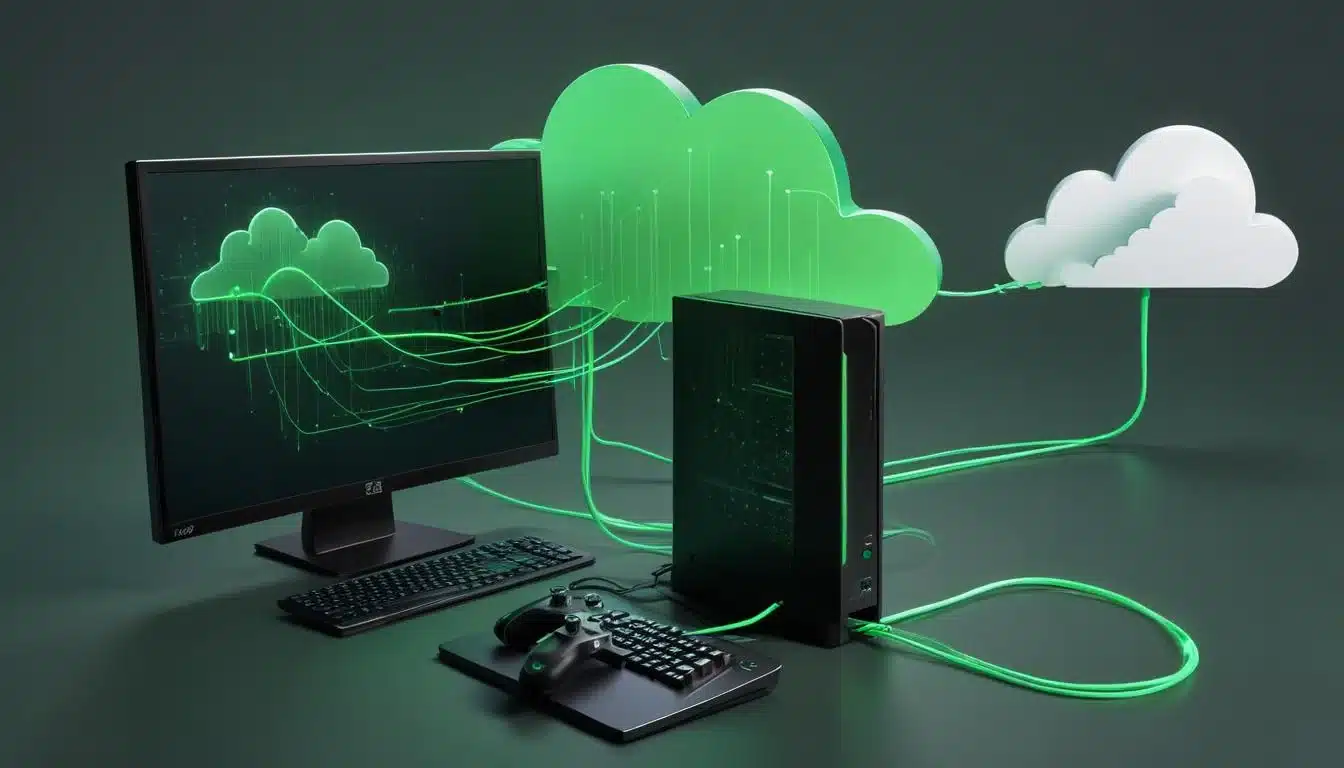Xbox Cloud Gaming Lagging? 7 Proven Tips to Boost Your Streaming Speed Today

Is your Xbox Cloud Gaming lagging, turning epic battles into frustrating slideshows? You’re not alone. Many gamers face this challenge, but with the right strategies, you can transform your cloud gaming experience from choppy to flawlessly smooth.
Understanding Xbox Cloud Gaming Lag
Xbox Cloud Gaming, a revolutionary service, allows you to stream high-fidelity games directly to your devices without needing a powerful console. However, this convenience comes with a reliance on a stable and fast internet connection. Lag, in this context, refers to the delay between your input and the game’s response, often manifesting as stuttering visuals or unresponsive controls.
The core issue behind cloud gaming lag is typically network latency and bandwidth limitations. Latency is the time it takes for data to travel from your device to the Xbox servers and back, while bandwidth is the amount of data your connection can handle. Both are critical for a seamless streaming experience.
The Role of Latency and Bandwidth
Latency, often measured in milliseconds (ms), is paramount for interactive applications like gaming. High latency means your button press takes longer to register on the server and for the game’s reaction to be displayed on your screen. Bandwidth, on the other hand, determines the quality of the stream you receive. Insufficient bandwidth can lead to lower resolution, compression artifacts, or even dropped frames.
- Latency (Ping): Crucial for real-time responsiveness. Lower is always better.
- Bandwidth (Download/Upload Speed): Essential for high-quality video and smooth data flow. Higher speeds support better graphical fidelity.
- Jitter: Variation in latency, leading to inconsistent performance.
Understanding these fundamental concepts is the first step toward diagnosing and resolving your cloud gaming lag. Without adequate attention to both, even the fastest internet speed might not deliver the smooth experience you expect.
In summary, Xbox Cloud Gaming lag is a complex issue stemming primarily from network performance. By understanding the interplay of latency and bandwidth, gamers can begin to pinpoint the root causes of their streaming woes and apply targeted solutions to improve their gameplay.
Optimize Your Internet Connection
Your internet connection is the backbone of your Xbox Cloud Gaming experience. A slow or unstable connection is the most common culprit behind lag. Optimizing it can yield the most significant improvements.
Start by evaluating your current internet plan. While Xbox Cloud Gaming recommends a minimum of 20 Mbps, a higher speed, especially for households with multiple users or devices, is always beneficial. Consider upgrading your plan if your current speeds consistently fall below this threshold, particularly during peak usage hours.
Wired Connection vs. Wi-Fi
A wired Ethernet connection is almost always superior to Wi-Fi for cloud gaming. Ethernet cables provide a more stable, faster, and lower-latency connection by eliminating interference and signal degradation common with wireless networks.
- Stability: Wired connections are less prone to drops and fluctuations.
- Speed: Often delivers faster download and upload speeds.
- Latency: Significantly reduces ping compared to Wi-Fi.
If a wired connection isn’t feasible, ensure your Wi-Fi setup is optimal. Placing your router in a central location, away from obstructions, and utilizing the 5GHz band can help. The 5GHz band offers faster speeds and less interference than the 2.4GHz band, though its range is shorter.
Another crucial step is to restart your modem and router periodically. This simple action can resolve temporary network glitches and refresh your connection, often leading to improved performance. Moreover, ensure your router’s firmware is up to date, as manufacturers frequently release updates that enhance performance and security.
In essence, a robust internet connection is non-negotiable for enjoyable cloud gaming. Prioritizing a wired connection and optimizing your wireless setup are fundamental steps to mitigate lag and enhance your streaming speed.
Reduce Network Congestion
Network congestion occurs when too many devices or applications are simultaneously using your internet connection, competing for bandwidth. This can significantly impact your Xbox Cloud Gaming performance, even if you have a fast internet plan.
To alleviate congestion, identify and minimize other internet activities during your gaming sessions. This includes pausing large downloads, stopping video streaming on other devices, and disabling automatic updates for software or operating systems. Even background applications on your gaming device can consume valuable bandwidth.
Prioritize Gaming Traffic
Many modern routers offer Quality of Service (QoS) settings, which allow you to prioritize certain types of network traffic. By configuring QoS, you can ensure that your Xbox Cloud Gaming traffic receives preferential treatment, guaranteeing it has sufficient bandwidth even when other devices are active.
- Identify Gaming Device: Assign high priority to your gaming PC, console, or mobile device.
- Prioritize Game Traffic: Some routers allow prioritizing specific applications or ports used by cloud gaming.
- Monitor Usage: Regularly check your network activity to identify bandwidth hogs.
Additionally, consider the number of devices connected to your network. Each connected device, even if not actively streaming, consumes some network resources. Disconnecting unused devices can free up bandwidth and reduce potential interference.
Another often overlooked aspect is the physical proximity of your gaming device to your router. The closer your device, especially when using Wi-Fi, the stronger and more stable your connection will be, reducing the likelihood of signal degradation contributing to congestion.
Ultimately, managing network congestion is about intelligent resource allocation. By prioritizing your gaming traffic and minimizing competing activities, you create a dedicated pathway for your Xbox Cloud Gaming, significantly enhancing its performance.

Optimize Your Device Settings
Beyond your internet connection, the device you use for Xbox Cloud Gaming can also impact performance. Proper device optimization ensures that your system can efficiently process the streamed video and audio without introducing additional latency or stutter.
For PC users, ensuring your graphics drivers are up to date is crucial. Outdated drivers can lead to performance bottlenecks and compatibility issues. Regularly check for updates from your GPU manufacturer (NVIDIA, AMD, Intel). Similarly, keeping your operating system updated can provide performance enhancements and bug fixes relevant to streaming.
Close Background Applications
Background applications consume CPU, RAM, and network resources, all of which can detract from your cloud gaming experience. Before launching an Xbox Cloud Gaming session, close any unnecessary programs, browser tabs, and background processes.
- Task Manager (Windows): Use it to identify and close resource-intensive applications.
- Activity Monitor (macOS): Similar tool for Mac users to manage processes.
- Mobile Devices: Close apps running in the background to free up resources.
Consider using your device’s ‘Game Mode’ if available. Many operating systems and gaming devices offer a dedicated game mode that automatically prioritizes gaming processes, reduces notifications, and optimizes resource allocation for better performance.
For mobile devices, ensure your device has sufficient free storage. A device running low on storage can experience performance slowdowns. Also, using a compatible and well-charged battery can prevent performance throttling that sometimes occurs when a device is low on power.
In conclusion, optimizing your device settings is about creating an environment where Xbox Cloud Gaming can run unimpeded. By updating drivers, closing background apps, and utilizing game modes, you empower your device to deliver the best possible streaming quality.
Choose the Right Server Region
The physical distance between your location and the Xbox Cloud Gaming servers plays a significant role in latency. Data has to travel further to reach a more distant server, naturally increasing your ping and potentially causing more noticeable lag.
Xbox Cloud Gaming automatically attempts to connect you to the nearest available server. However, sometimes this automatic selection might not be optimal, or regional server loads might vary. If you suspect you’re connecting to a distant or congested server, you might be able to manually adjust your region settings within the Xbox app or through your device’s network settings.
How Server Distance Affects Latency
Every mile data travels adds a tiny fraction of a second to latency. While individually small, these add up over long distances. High latency can make fast-paced games feel sluggish and unresponsive, even with ample bandwidth.
- Geographic Proximity: Closer servers mean lower latency.
- Server Load: A physically close but overloaded server can still perform worse than a slightly more distant, less congested one.
- Routing Efficiency: The path data takes can also influence latency, not just direct distance.
Experimenting with different server regions, if possible, can help you find the one that offers the lowest ping. Tools like network diagnostic utilities or simple ping tests can help you measure latency to various locations, guiding your decision.
Additionally, external factors like your Internet Service Provider’s (ISP) routing can influence which server appears ‘closest’ in terms of ping. Some ISPs might have more direct routes to certain data centers than others, making their network more efficient for cloud gaming.
To summarize, selecting the optimal server region is a critical but often overlooked factor in mitigating Xbox Cloud Gaming lag. By ensuring you connect to the nearest and least congested server, you can significantly reduce latency and improve your overall streaming experience.

Utilize a VPN (With Caution)
A Virtual Private Network (VPN) can sometimes improve Xbox Cloud Gaming performance, but it’s a tool to be used with caution and understanding. While a VPN typically adds a layer of encryption and routing that can introduce latency, it can also bypass ISP throttling or inefficient routing paths.
If your ISP is intentionally slowing down your connection to certain services (throttling), a VPN can mask your activity, potentially restoring your full bandwidth. Moreover, some VPNs offer optimized servers that might provide a more direct, lower-latency route to Xbox Cloud Gaming servers than your ISP’s default routing.
When a VPN Can Help and When It Can Hurt
A VPN might help if your ISP is throttling or has poor routing. However, if your ISP provides excellent, direct routing and no throttling, a VPN will almost certainly increase your latency due to the additional hop and encryption overhead.
- Potential Benefits: Bypass ISP throttling, improve routing, enhance privacy.
- Potential Drawbacks: Increased latency, reduced bandwidth, additional cost.
- Selection: Choose a VPN provider known for speed and gaming-optimized servers.
Before committing to a VPN solution, it’s advisable to test its impact on your connection. Many VPN services offer free trials or money-back guarantees. Run speed tests and in-game latency checks both with and without the VPN connected to gauge its effectiveness for your specific situation.
It’s also important to select a reputable VPN provider. Free VPNs often come with limitations on speed and data, which are counterproductive for cloud gaming. Premium VPNs, while costing money, typically offer better performance and a wider selection of servers.
In essence, a VPN is a nuanced tool for addressing Xbox Cloud Gaming lag. While it can be a lifesaver for specific network issues like ISP throttling or suboptimal routing, it’s not a universal solution and should be implemented only after careful consideration and testing.
Check for Software Conflicts
Even with a perfect internet connection and optimized device settings, software conflicts can secretly sabotage your Xbox Cloud Gaming experience. These conflicts often arise from security software, other VPNs, or network monitoring tools interfering with the game streaming process.
Antivirus programs, firewalls, and anti-malware software, while essential for security, can sometimes aggressively scan network traffic or block connections that they deem suspicious. This can introduce delays or even prevent the cloud gaming stream from functioning correctly.
Temporarily Disable Security Software
As a diagnostic step, try temporarily disabling your antivirus and firewall to see if it resolves the lag. If it does, you’ll need to configure exceptions for the Xbox app and related services within your security software’s settings. Never browse the internet or download files with your security software disabled.
- Antivirus: Add exceptions for Xbox Cloud Gaming application files.
- Firewall: Ensure the Xbox app has permission to access the internet.
- Other VPNs/Proxies: Make sure no other network-altering software is running concurrently.
Beyond security software, other applications that monitor or modify network traffic could also be problematic. This includes certain network optimization tools or even other VPN clients that might be running in the background unintentionally.
It’s also worth checking your operating system’s built-in network diagnostics. These tools can sometimes identify underlying software conflicts or network configuration issues that are silently impacting your streaming performance.
To conclude, software conflicts can be elusive but significant contributors to Xbox Cloud Gaming lag. By methodically checking and configuring your security software and other network-related applications, you can eliminate these hidden performance bottlenecks.
Clear Cache and Reinstall App
Sometimes, the solution to persistent Xbox Cloud Gaming lag is surprisingly simple: clearing your app’s cache or even reinstalling the application. Over time, cached data can become corrupted or outdated, leading to performance issues and glitches.
Cached data is designed to speed up application loading times, but when it becomes problematic, it can have the opposite effect. A fresh cache ensures that the application is working with the most current and correct data, which can resolve unexpected slowdowns or streaming hiccups.
Steps for Clearing Cache and Reinstallation
The process for clearing cache varies by device. On Android, you can typically go to App Info > Storage > Clear Cache. On Windows, you might clear the Microsoft Store cache or reset the Xbox app from the Apps & Features settings.
- Clear App Cache: Remove temporary files that might be causing issues.
- Reinstall Application: A clean installation can fix deeper software corruptions.
- Restart Device: Always restart your device after clearing cache or reinstalling.
Reinstalling the Xbox app should be considered if clearing the cache doesn’t resolve the issue. A complete reinstallation ensures that all app files are fresh and correctly configured, eliminating any lingering corruptions that might be causing lag.
For web-based cloud gaming, clearing your browser’s cache and cookies is the equivalent step. Browser extensions can also interfere, so try playing in incognito mode or with extensions disabled to rule them out.
In summary, don’t underestimate the power of a fresh start. Clearing the app cache or reinstalling the Xbox Cloud Gaming application can often resolve stubborn lag issues that might not be directly related to your internet connection or hardware.
| Tip | Benefit |
|---|---|
| Wired Connection | Reduces latency and improves stability over Wi-Fi. |
| Reduce Congestion | Frees up bandwidth by minimizing other network activities. |
| Optimize Device | Ensures device resources are prioritized for gaming. |
| Server Region | Minimizes latency by connecting to the nearest server. |
Frequently Asked Questions About Cloud Gaming Lag
Microsoft recommends a minimum of 20 Mbps for Xbox Cloud Gaming. However, for the best experience, especially in a household with multiple internet users, speeds of 50-100 Mbps or higher are preferable to ensure smooth, high-quality streaming without interruptions or noticeable lag.
Yes, an outdated or poorly configured router can significantly contribute to cloud gaming lag. Older routers might lack the processing power or Wi-Fi standards (like Wi-Fi 5 or 6) needed for efficient streaming. Ensuring your router’s firmware is updated and utilizing QoS settings can help.
Generally, yes. The 5GHz Wi-Fi band offers faster speeds and less interference from other devices compared to the 2.4GHz band. While its range is shorter, if you’re close to your router, 5GHz can provide a more stable and faster connection crucial for cloud gaming.
Absolutely. Background applications consume valuable CPU, RAM, and network resources. Closing unnecessary programs, browser tabs, and background processes frees up these resources, allowing your device to dedicate more power and bandwidth to the Xbox Cloud Gaming stream, reducing potential lag.
A VPN’s impact varies. It can help if your ISP is throttling or has inefficient routing, potentially lowering latency. However, in many cases, a VPN might add latency due to extra encryption and routing. Test with and without a VPN to see if it improves your specific connection.
Conclusion
Experiencing lag with Xbox Cloud Gaming can be incredibly frustrating, but it’s a problem with numerous actionable solutions. By methodically addressing factors like your internet connection’s speed and stability, reducing network congestion, optimizing your gaming device, and even considering advanced options like VPNs or server region selection, you can significantly enhance your streaming experience. Remember, a smooth cloud gaming session is a combination of robust network infrastructure, efficient device performance, and smart troubleshooting. Don’t let lag hold you back; implement these proven tips today and immerse yourself fully in the expansive world of Xbox Cloud Gaming.